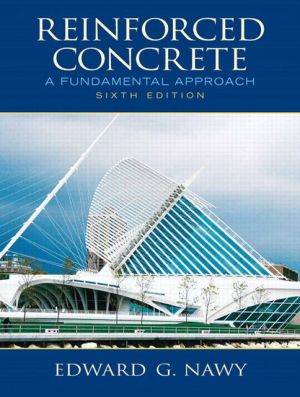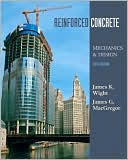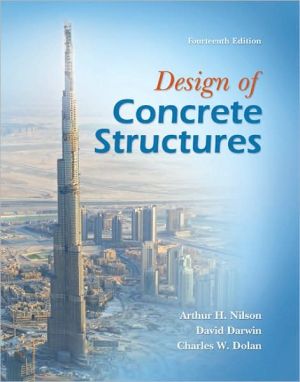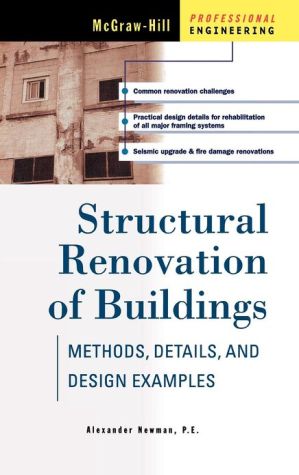Reinforced Concrete: A Fundamental Approach
Reinforced Concrete: A Fundamental Approach\ Edition: Sixth\ Author(s): Edward G. Nawy\ ISBN-13 : 978-0-13-241703-7\ ISBN-10: 0-13-241703-0\ This new edition of Edward G. Nawy’s highly acclaimed work reflects the very latest ACI-318-08 Building Code and includes these major changes and additions:\ × All design examples conform to the Strain Limits Design Method, using the applicable load factors and strength reduction factors.\ × An updated chapter on seismic design of buildings to comply...
Search in google:
Now reflecting the new 2008 ACI 318-08 Code and the new International Building Code (IBC-2006), this cutting-edge text has been extensively revised to present state-of-the-art developments in reinforced concrete.The text analyzes the design of reinforced concrete members through a unique and practical step-by-step trial and adjustment procedure. It is supplemented with flowcharts that guide readers logically through key features and underlying theory. Hundreds of photos of tests to failure of concrete elements help readers visualize this behavior.Ideal for practicing engineers who need to contend with the new revisions of the ACI, IBC, and AASHTO Codes. Booknews A text for a one-semester undergraduate course or graduate course in reinforced concrete in standard civil engineering programs. Provides thorough coverage of short- and long-term material behavior, design of concrete mixtures, reliability and structural safety, serviceability behavior of beams and slabs, continuity in concrete structures, and seismic design of high rise buildings in earthquake zones. Sketches and sets of working drawings, chapter problems, b&w photos of actual structural tests to failure, and flowcharts are featured. The author teaches civil and environmental engineering at Rutgers, The State University of New Jersey. Annotation c. Book News, Inc., Portland, OR (booknews.com)
PREFACE: \ PREFACE\ Reinforced concrete is a widely used material for constructed systems. Hence, graduates of every civil engineering program must have, as a minimum requirement, a basic understanding of the fundamentals of reinforced concrete. Additionally, design of the members of a total structure is achieved only by trial and adjustment: assuming a section, then analyzing it. Consequently, design and analysis were combined to make it simpler for the student first introduced to the subject of reinforced concrete design.\ This fourth edition of the book revises the previous text so as to conform to the ACI 318-99 Code and also to include major additional topics in several chapters such as in Chapter 3 on concrete materials, Chapter 5 on flexure, Chapter 8 on serviceability, Chapter 9 on compression members, and Chapter 15 on seismic design of structures. Chapter 15 on seismic design of concrete structures has been completely rewritten so as to conform to the new provisions of the International Building Code (IBC 2000) on seismic design.\ To Chapter 3 was added a complete discussion with a computational example for the design of concrete mixtures for high-strength high-performance concrete. To Chapter 5 was added a new section dealing with the strain limits approach of Appendix B of the ACI 318-99 Code. All the examples in this chapter were also solved by the strain limits approach. Discussion and design examples were also added for proportioning concrete floor joists. The provisions for crack control in Chapter 8 for beams and one-way slabs were changed and the examples revamped in order to conform to the new ACI-318-99 provisions. Additional topics wereadded to Chapter 9 in order to give alternative methods for the design of columns subjected to biaxial bending. Specifically, a modified, simpler reciprocal method using moments rather than loads was added in addition to the Bressler reciprocal method, and design examples were added to illustrate the different methods. Chapter 15 on seismic design of concrete structures was rewritten to conform both to the ACI 318-99 new Chapter 21 as well as the new International Building Code, IBC 2000. Equations for both the spectral response method and the equivalent static load method have been systematically presented and several additional design examples for the base shear force, confinement, probable moments, and a full shear wall design example for a high-rise building have been given.\ In addition to the prolific number of analysis and design examples in the book as well as the numerous flowcharts, another significant feature of this edition is the inclusion of examples in SI units in most of the chapters and a listing of the relevant equation in the SI format. In this manner, the student as well as the practicing engineer can avail themselves of the tools for transition from the lb-in. (PI) system to the System International (SI) where needed.\ The text is an outgrowth of the author's lecture notes evolved in teaching the subject at Rutgers University over the past forty years and the experience accumulated over the years in teaching and research in the areas of reinforced and prestressed concrete inclusive of the Ph.D. level. The material is presented in such a manner that the student can be familiarized with the properties of plain concrete and its components both for normal strength and high-performance concrete, prior to embarking on the study of structural behavior. The book is uniquely different from other textbooks at this level in that a good segment of its contents can be covered in one semester in spite of the in-depth discussions of some of its major topics.\ The concise discussion presented in Chapters 1 through 4 on the historical development of concrete, the proportioning of the constituent materials, long-term basic behavior, and the development of safety factors should give an adequate introduction to the subject of reinforced concrete. It should also aid in developing fundamental laboratory experiments and essential knowledge of mixture proportioning, strength and behavioral requirements, and the concepts of reliability of performance of structures to which every engineering student and engineer should be exposed. The discussion of quality assurance should also give the reader a good introduction to a systematic approach needed to administer the development of concrete structural systems from conception to turnkey use.\ Since concrete is a nonelastic material, with the nonlinearity of its behavior starting at a very early stage of loading, only the ultimate strength approach, or what is sometimes termed the "limit state at failure approach," is given in this book. Adequate coverage is given of the serviceability checks in terms of cracking and deflection behavior as well as long-term effects. In this manner, the design should satisfy all the serviceloadlevel requirements while ensuring that the theory used in the analysis (design) truly describes the actual behavior of the designed components.\ Chapters 5, 6, 7, and 8 cover the flexural, diagonal tension, torsion, and serviceability behavior of onedimensional members: beams and one-way slabs. Full emphasis has been placed on giving the student and the engineer a feeling for the internal strain distribution in structural reinforced concrete elements and a basic understanding of the reserve strength and the safety factors inherent in the design expressions. Chapter 9, on the analysis and design of columns and other compression members, treats the subject of strain compatibility and strain distribution in a similar manner as in Chapter 5 on flexural analysis and design of beams. It includes a detailed discussion of how to construct interaction diagrams for columns as well as proportioning columns subjected to biaxial bending and buckling as well as the P-delta effect.\ It is important to mention that Chapter 6, on diagonal tension, also contains detailed coverage of the behavior of deep beams, corbels, and brackets, with sufficient design examples to supplement the theory. This topic has been included in view of the increased use of precast construction, the wider understanding of the effects of induced horizontal loads on floors, and the frequent need for including shear walls and deep beams in today's multilevel structures. Additionally, Chapter 7 treats the topic of torsion in some detail considering the space constraints of the book. The discussion ranges from the basic fundamentals of pure torsion in elastic and plastic materials to the design of reinforced concrete members subjected to combined torsion, shear, and bending. The material presented and the accompanying illustrative examples should give the background necessary for pursuing more advanced studies in this area, as listed in the selected references. Chapter 10 covers in detail the latest ACI Code provision on bond development of reinforcement while Chapter 12 covers design of foundations.\ Chapter 11 presents an extensive coverage of the subject of analysis and design of two-way slab and plate floor systems. Following a discussion of fundamental behavior, it gives detailed design examples using both the ACI procedures and yield-line theory for the flexural design of reinforced concrete floors. It also includes ultimate load solutions to most floor shapes and possible gravity loading patterns. Detailed discussion of the deflection behavior and evaluation of two-way panels as well as the cracking mechanism of such panels, with appropriate analysis examples, makes this chapter another unique feature of this concise textbook.\ Chapter 13 deals with continuous reinforced concrete structures. It presents a review of the various methods of analysis for continuity of multispan beams and portals and gives relevant examples including those on the topics of limit theory and plastic hinging. Chapter 14 is an introduction to prestressed concrete. It should serve as a brief treatment of the subject in order to illustrate the fundamental differences between reinforced and prestressed concrete. As discussed above, Chapter 15, dealing with the seismic behavior of concrete structures, is one of the highlights of this book since it presents the subject in as concise a manner as possible, yet it is comprehensive enough to give several examples on the proportioning of elements of a frame and a shear wall with boundary elements, conforming to the latest ACI and IBC 2000 provisions.\ It is important to emphasize that in this field, the use of computers prevails today. Access to transportable personal computers, due to their affordable cost, has made it possible for almost every student to be equipped with such a tool. Hence, the extensive flowcharts presented throughout the book should aid the students or the designers in writing their own computer programs. Also, Appendix A contains eight computer programs written in Q-BASIC for DOS and Windows, covering the topics of flexure, shear, torsion, combined loading, brackets and corbels, and deep beams. As a result, the use of handbook charts was kept to a minimum in Appendix B. Computer program 32 inch diskettes can be purchased from the author as indicated in Appendix A. The numerous flowcharts for every topic presented in this book should aid the user in developing the logic and step-by-step thinking in easily comprehending the analysis and design procedures for efficient reinforced concrete systems.\ Selected photographs of various areas of structural behavior of concrete elements at failure are included in all the chapters. They are taken from the published research work by the author with many of his M.S. and Ph.D. students at Rutgers University over the past four decades. Additionally, photographs of landmark structures, mainly in the United States, are included throughout the book to illustrate the versatility of design in reinforced concrete.\ The textbook conforms to the provisions of ACI 318-99 with an eye to stressing the basics rather than tying every step to the code, which changes once every six years. Consequently, no attempt was made to tie any design or analysis step to the particular equation numbers in the code, but rather, the student is expected to gain the habit of getting familiar with the provisions and section numbers of the ACI Code as a dynamic, everchanging document. Conversions to SI units are included in the illustrative examples throughout the book, in addition to the separate solutions in SI units which have been added to most chapters in this edition.\ The various topics have been presented in as concise a manner as possible but without sacrificing the need for the instructional details by students first exposed to reinforced concrete design. Hence, the topic of prestressed concrete has been only briefly covered in Chapter 14, and the reader is left to pursue more advanced works such as the author's book Prestressed Concrete: A Fundamental Approach (3rd ed., 2000) also conforming to the ACI 318-99 Code.\ Portions of this book are intended for a first course at the junior or senior level of the standard college or university curriculum in civil engineering while the advanced topics can be adequately covered for use at the graduate level. The contents should also serve as a valuable guideline to the practicing engineer who has to keep abreast of the state of the art in concrete, as well as the designer who is interested in a concise treatment of the fundamentals.\ ACKNOWLEDGMENTS\ Grateful acknowledge is due to the American Concrete Institute for contribution to the author's accomplishments and for permitting generous quotations of its ACI 318 Code and the illustrations from other ACI publications. Special mention is made of his original mentor, the late Professor A. L. L. Baker of London University's Imperial College of Science, Technology, and Medicine, who inspired him with the affection that he had developed for systems constructed of concrete. Grateful acknowledgment is also made to the author's many students, both undergraduate and graduate, who have had much to do with generating the writing of this book; to the many who assisted in his research activities over the years, shown in the various photographs of laboratory tests throughout the book, and to the many colleagues at other universities who have continuously used the book and have given advice and suggestions over the years for modifications and additions.\ Thanks are due to the panel of reviewers of the first edition: Professor William J. Hall of the University of Illinois at Urbana, Engineering Editor of the Prentice Hall Advanced Series; Professor Vitelmo V. Bertero of the University of California at Berkeley; Professor Dan E. Branson of the University of Iowa; and particularly to Professor Thomas T. C. Hsu of the University of Houston who has meticulously reviewed and contributed to the chapters on shear and torsion in the first and the subsequent editions of this book, for their suggestions and advice. Thanks also to Professor P. N. Balaguru of Rutgers, for his input to the flexure and axial load sections of the first edition, to engineer Mark J. Cipollone, MS Rutgers, for his input to the original manuscript; to Regina Silviera Rocha Souza, MS Rutgers, for her ideas and computational review of the first edition; to Robert M. Nawy, BA BS MBA Rutgers engineering class of 1983, for his extensive work on the solutions; and to engineers Abe Daly and Lily Sehayek, Ph.D, Rutgers, for their input to some of the first edition original computer programs in Q-BASIC.\ Special gratitude and thanks for this edition are due to Dr. Basile G. Rabbat, PCA Manager, Transportation Structures and Structural Codes, Professor Thomas T. C. Hsu of the University of Houston; Dr. Douglas D. Lee, President of Douglas D. Lee Associates; Dr. S. K. Ghosh, Consulting Engineer, Professor Murat Saatcioglu of the University of Ottawa, and Professor Alex Aswad of Penn State University at Harrisburg, for their input and advice during the development of changes made to the second, third and fourth editions.\ Grateful acknowledgment is also made to the Prentice Hall officers and staff, particularly to Marcia Horton, Editor-in-Chief for her support over the years, to Associate Editor Alice Dworkin, to Executive Senior Production Editor Vincent O'Brien, and staff contact Dolores Mars, and to Patty Donovan, Senior Coordinator, Pine Tree Composition, Inc., for commendable efforts in bringing to fruition this fourth enlarged edition of the book. Last but not least, the author is grateful to his former students: Anand Bhatt, and Ryan Laub, both MS Rutgers, and Moira Treacy, M.S. Princeton, for their diligent contribution to the additional computational and processing work in this edition.\ Edward G. Nawy\ Rutgers University\ The State University of New Jersey\ Piscataway, New Jersey
Preface1Introduction12Concrete-Producing Materials83Concrete234Reinforced Concrete655Flexure in Beams906Shear and Diagonal Tension in Beams1557Torsion2128Serviceability of Beams and One-Way Slabs2739Combined Compression and Bending: Columns32710Bond Development of Reinforcing Bars41311Design of Two-Way Slabs and Plates45812Footings56413Continuous Reinforced Concrete Structures60314Introduction to Prestressed Concrete66815Seismic Design of Concrete Structures721Appendix A Computer Programs in Basic767Appendix B Tables and Nomograms799Index827
\ BooknewsA text for a one-semester undergraduate course or graduate course in reinforced concrete in standard civil engineering programs. Provides thorough coverage of short- and long-term material behavior, design of concrete mixtures, reliability and structural safety, serviceability behavior of beams and slabs, continuity in concrete structures, and seismic design of high rise buildings in earthquake zones. Sketches and sets of working drawings, chapter problems, b&w photos of actual structural tests to failure, and flowcharts are featured. The author teaches civil and environmental engineering at Rutgers, The State University of New Jersey. Annotation c. Book News, Inc., Portland, OR (booknews.com)\ \








